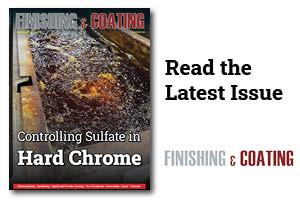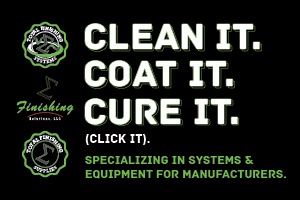A shop manager wrote to me asking for advice on their acid copper issue.
 Frank AltmayerThe shop mostly plated zinc die castings, and the manager says the current density range is very dramatic because the parts they plate are casket trim die castings. He says they periodically get blisters and are confused about how much chloride should be in their solution.
Frank AltmayerThe shop mostly plated zinc die castings, and the manager says the current density range is very dramatic because the parts they plate are casket trim die castings. He says they periodically get blisters and are confused about how much chloride should be in their solution.
They reported that one consultant told them it shouldn’t be over 80 ppm, while another said it should be 100. They asked if there was an easy way to analyze chloride.
Their latest problem was that the solution gave off a strong odor, making their eyes tear.
The odor problem was determined to be related to the solution's operation at twice the recommended amount of sulfuric acid and the fact that it air-agitates and doesn’t ventilate the tank. After reducing the acid concentration back to the normal range, the problem disappeared.
In top photo: Microscopic cross section, 400X, blistered nickel-silver electroplate over zinc diecasting caused by inadequate copper strike.
Purpose of Acid Copper Plating
Acid copper is plated in several applications to take advantage of this process’s ability to deliver a highly leveled, bright surface over a wide range of current densities. Applications include the rotogravure industry, electroforming, and plating onto castings. Your specific application— plating onto slush castings—utilizes acid copper:
- To allow for “leveling” of the polished surface of the castings: Leveling is the ability of certain plating processes to fill in tiny scratches in the surface of a part. Acid copper is considered to be the plating solution that offers the highest degree of leveling ability.
- For buildup of copper for further polishing/buffing, as necessary: Slush castings often contain small surface imperfections, such as surface and subsurface pits. When polished before plating, these pits become more pronounced and trap chemical solutions, causing the final product to be spotted later. Some small pits and surface imperfections can be eliminated by plating a heavy thickness of acid copper, then buffing the surface, to smear the copper over the surface imperfections. This process of “saving” a casting with imperfections is not always successful. It depends upon the size and location of the imperfections. There are other imperfections in castings, such as “cold shuts,” which cannot be corrected or compensated for by acid copper plating.
- To obtain a bright surface that requires little buffing and allows for the next plating processes, such as nickel and gold plating, to be fully bright.
- An acid copper deposit is very fine-grained and pore-free for long-term protection against staining and corrosion by the atmosphere (when over-plated with other metals, such as nickel and chromium). It will enhance the corrosion resistance of a nickel and chromium plated part.
Overview of Plating Process
Zinc castings cannot be directly plated in the acid copper plating solution. The solution will chemically react with the casting's surface, resulting in an ugly surface that might have loosely adherent copper.
The correct process sequence for plating these castings is:
- The electrocleaner removes surface dirt.
- The rinse removes residual electrocleaner.
- Dilute Acid Dip. The acid removes surface oxides and neutralizes the alkali remaining on the surface after electrocleaning.
- The rinse after acid removes traces of acid that remain on the parts.
- Cyanide Copper Strike. This solution does not chemically react with the casting, so it can be used to plate a very thin layer of copper over it. Rinsing is unnecessary after the cyanide copper strike because the next step is removing the cyanide copper plate.
- Cyanide Copper Plate. The cyanide copper plate step builds up the thickness of copper to a point where enough of the casting is well covered in copper, so there is no chemical attack when placed into the acid copper plating solution. If the copper thickness on the casting is too thin, blistering will result. The part you submitted had no copper on the casting (less than 0.000005).
- After cyanide copper plating, the rinse removes cyanide from the surface so it can’t react with the next step (acid dipping).
- Sulfuric Acid Dip. The acid dip conditions the surface for the next step, acid copper plating.
- Parts should be rinsed before they go into the acid copper plating tank to remove excess acid and keep out impurities from the cyanide copper solution.
Acid Copper-Overview
The acid copper plating process consists of two basic ingredients, a tiny amount of hydrochloric acid, and additives to obtain brightening and leveling. The process should deliver a bright, ductile, easily buffed copper deposit.
Making a New Solution
To make a new solution (150 gal in volume), follow these steps:
- Fill a mixing tank (not the plating tank!) with 100 gal of water. Deionized water is preferred, but tap water can be used. The water should be tested by a laboratory for chloride content so that the chloride can be adjusted to the right ppm. For example, tap water in Chicago contains about 15 ppm of chloride, which should be compensated for when adding hydrochloric acid. Deionized water contains no chloride. If at all possible, heat the water to around 140° If this is not possible, it will take much longer to make up the plating solution.
- Add 260 lb of copper sulfate crystals (CuSO4 5H2O) and stir the water with a prop mixer until all the copper sulfate is dissolved.
- Add 7 lb of activated carbon powder. Mix for 1 hour, then allow the carbon to settle for 2 hours.
- Filter the solution into the plating tank or a second mixing tank without disturbing the carbon that settles at the bottom of the tank. Be careful that none of the carbon is brought into the filtered tank. The last liquid at the bottom (containing all the carbon) must be disposed of.
- Transfer the filtered solution to the plating tank, and run the filter
- continuously overnight with a high amount of tank agitation. The solution should be so clear that no carbon or other solids are visible. A laboratory can filter through a glass fiber membrane to confirm that all the carbon has been removed.
- The solution should be allowed to cool to room temperature. With a high amount of agitation, slowly add six gal of concentrated sulfuric acid to the plating tank. If the acid is added too quickly, it might violently react with the water, so be sure to wear all the protective equipment called for in the MSDS and follow all safety precautions given in that document. Allow the solution to cool again to room temperature (a maximum of 95°F).
- Adjust the chloride concentration by adding concentrated hydrochloric acid (15 mL to 150 gal equals 10 ppm of chloride). Assuming deionized water was used, you will need about 100 mL of hydrochloric acid. The safest way to do this is to add half the amount (50 mL) and have the solution analyzed. Then add the rest if the analysis shows you need more. Adding too much hydrochloric acid makes it nearly impossible to get it lowered. You will need to take some of the plating solution out and replace it with chloride-free plating solution. Therefore, it is best to proceed carefully and add less than you think is needed, because you can always add more later.
- Add the brightener(s) and leveling agent(s).
- Using unnecessary parts (dummies), plate for 15–20 minutes under normal conditions before using the solution on production parts.
Frank Altmayer is a Master Surface Finisher, an AESF Fellow, and the technical education director of the AESF Foundation and NASF. He owned Scientific Control Laboratories from 1986 to 2007 and has over 50 years of experience in metal finishing. He received the AESF Past Presidents Award, NAMF Award of Special Recognition, AESF Leadership Award, AESF Fellowship Award, Chicago Branch AESF Geldzahler Service Award, and NASF Award of Special Recognition.



































